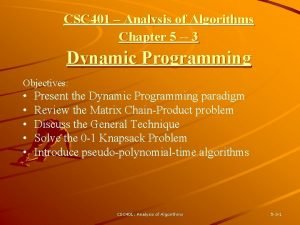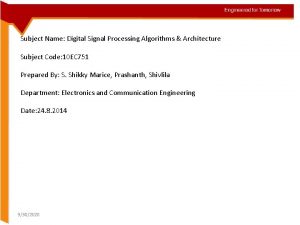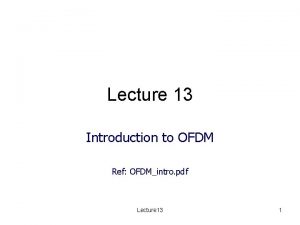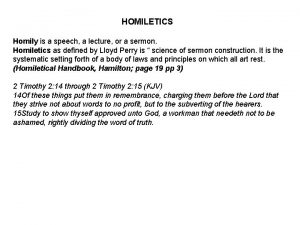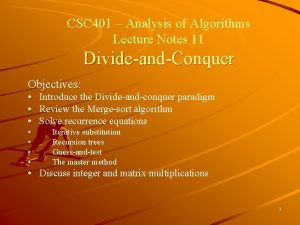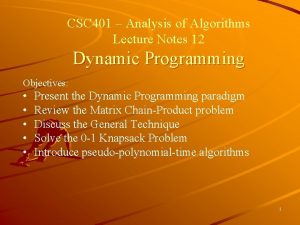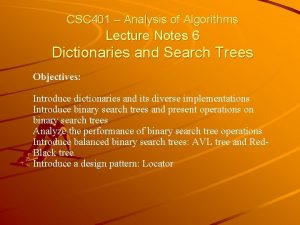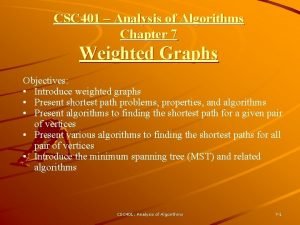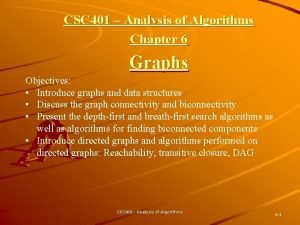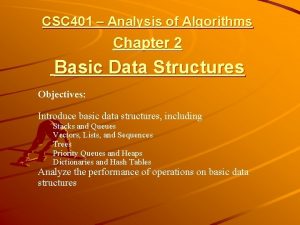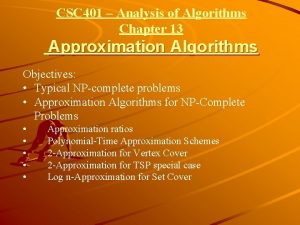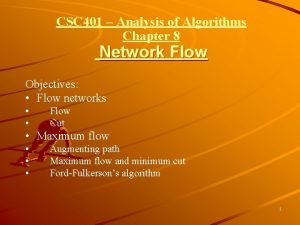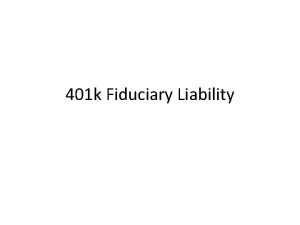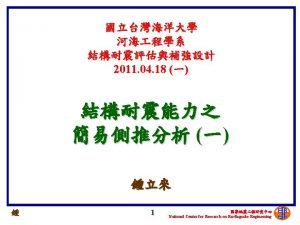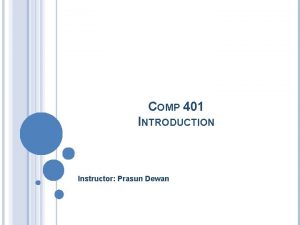CSC 401 Analysis of Algorithms Lecture Notes 13































- Slides: 31

CSC 401 – Analysis of Algorithms Lecture Notes 13 Graphs: Concepts, Representation, and Traversal Objectives: • • • Introduce graphs Present data structures for graphs Discuss the graph connectivity Present the depth-first search algorithm Present the breath-first search algorithm 1

Graph A graph is a pair (V, E), where – – – V is a set of nodes, called vertices E is a collection of pairs of vertices, called edges Vertices and edges are positions and store elements Example: 337 HNL 2555 LAX 3 4 7 1 1233 802 – A vertex represents an airport and stores the three-letter airport code – An edge represents a flight route between two airports and stores the mileage of the route 849 PVD 3 ORD 184 2 14 SFO 7 138 DFW LGA 1120 10 99 MIA 2

Edge Types Directed edge – – – ordered pair of vertices (u, v) first vertex u is the origin second vertex v is the destination – e. g. , a flight ORD flight AA 1206 PVD Undirected edge – unordered pair of vertices (u, v) – e. g. , a flight route Directed graph – all the edges are directed – e. g. , route network ORD 849 miles PVD Undirected graph – all the edges are undirected – e. g. , flight network 3

Applications Electronic circuits – Printed circuit board – Integrated circuit Transportation networks – Highway network – Flight network Computer networks – Local area network – Internet – Web Databases – Entity-relationship diagram 4

Terminology End vertices (or endpoints) of an edge – U and V are the endpoints of a Edges incident on a vertex – a, d, and b are incident on V Adjacent vertices – U and V are adjacent Degree of a vertex – X has degree 5 Parallel edges – h and i are parallel edges Self-loop – j is a self-loop a U V b d h X c e W j Z i g f Y 5

Terminology (cont. ) Path – sequence of alternating vertices and edges – begins with a vertex – ends with a vertex – each edge is preceded and followed by its endpoints Simple path – path such that all its vertices and edges are distinct Examples – P 1=(V, b, X, h, Z) is a simple path – P 2=(U, c, W, e, X, g, Y, f, W, d, V) is a path that is not simple a U c V b d P 2 P 1 X e W h Z g f Y 6

Terminology (cont. ) Cycle – circular sequence of alternating vertices and edges a – each edge is preceded and followed by its endpoints Simple cycle U – cycle such that all its vertices c and edges are distinct Examples – C 1=(V, b, X, g, Y, f, W, c, U, a, ) is a simple cycle – C 2=(U, c, W, e, X, g, Y, f, W, d, V, a, ) is a cycle that is not simple V b d C 2 X e C 1 g W f h Z Y 7

Property 1 Properties Sv deg(v) = 2 m Proof: each edge is counted twice Property 2 In an undirected graph with no self-loops and no multiple edges m n (n - 1)/2 Proof: each vertex has degree at most (n - 1) What is the bound for a directed graph? Notation n m deg(v) number of vertices number of edges degree of vertex v Example – n=4 – m=6 – deg(v) = 3 8

Main Methods of the Graph ADT Vertices and edges – are positions – store elements Accessor methods – – – – a. Vertex() incident. Edges(v) end. Vertices(e) is. Directed(e) origin(e) destination(e) opposite(v, e) are. Adjacent(v, w) Update methods – – – insert. Vertex(o) insert. Edge(v, w, o) insert. Directed. Edge(v, w, o) remove. Vertex(v) remove. Edge(e) Generic methods – – num. Vertices() num. Edges() vertices() edges() 9

Edge List Structure Vertex object – element – reference to position in vertex sequence u a Edge object – element – origin vertex object – destination vertex object – reference to position in edge sequence v u c b d w z w v z Vertex sequence – sequence of vertex objects a b c d Edge sequence – sequence of edge objects 10

Adjacency List Structure Edge list structure Incidence sequence for each vertex – sequence of references to edge objects of incident edges a v b u u w v w Augmented edge objects – references to associated positions in incidence sequences of end vertices a b 11

Adjacency Matrix Structure Edge list structure Augmented vertex objects a – Reference to edge object for adjacent vertices – Null for nonadjacent vertices The “old fashioned” version just has 0 for no edge and 1 for edge b u – Integer key (index) associated with vertex 2 D-array adjacency array v 0 u w 1 0 0 2 1 w 2 1 a 2 v b 12

Asymptotic Performance § n vertices, m edges § no parallel edges § no self-loops § Bounds are “big-Oh” Edge List n+m Space incident. Edges(v) m are. Adjacent (v, w) m insert. Vertex(o) 1 insert. Edge(v, w, o) 1 remove. Vertex(v) remove. Edge(e) m 1 Adjacency List Adjacency Matrix n+m deg(v) min(deg(v), deg(w)) 1 n 2 n 1 n 2 1 deg(v) 1 1 n 2 1 13

Trees and Forests A (free) tree is an undirected graph T such that – T is connected – T has no cycles This definition of tree is different from the one of a rooted tree A forest is an undirected graph without cycles The connected components of a forest are trees Tree Forest 14

Spanning Trees and Forests A spanning tree of a connected graph is a spanning subgraph that is a tree A spanning tree is not unique unless the graph is a tree Spanning trees have applications to the design of communication networks A spanning forest of a graph is a spanning subgraph that is a forest Graph Spanning tree 15

Depth-First Search Depth-first search (DFS) is a general technique for traversing a graph A DFS traversal of a graph G DFS on a graph with n vertices and m edges takes O(n + m ) time DFS can be further extended to solve other graph problems – Visits all the vertices and edges of G – Determines whether G is connected – Computes the connected components of G – Computes a spanning forest of G – Find and report a path between two given vertices – Find a cycle in the graph Depth-first search is to graphs what Euler tour is to binary trees 16

DFS Algorithm The algorithm uses a mechanism for setting and getting “labels” of vertices and edges Algorithm DFS(G) Input graph G Output labeling of the edges of G as discovery edges and back edges for all u G. vertices() set. Label(u, UNEXPLORED) for all e G. edges() set. Label(e, UNEXPLORED) for all v G. vertices() if get. Label(v) = UNEXPLORED DFS(G, v) Algorithm DFS(G, v) Input graph G and a start vertex v of G Output labeling of the edges of G in the connected component of v as discovery edges and back edges set. Label(v, VISITED) for all e G. incident. Edges(v) if get. Label(e) = UNEXPLORED w opposite(v, e) if get. Label(w) = UNEXPLORED set. Label(e, DISCOVERY) DFS(G, w) else set. Label(e, BACK) 17

A Example A A A unexplored vertex visited vertex unexplored edge discovery edge back edge B D E A C B D E A B D E C B D C A B C C A D E B D C E E 18

DFS and Maze Traversal The DFS algorithm is similar to a classic strategy for exploring a maze – We mark each intersection, corner and dead end (vertex) visited – We mark each corridor (edge ) traversed – We keep track of the path back to the entrance (start vertex) by means of a rope (recursion stack) 19

Properties of DFS Property 1 DFS(G, v) visits all the vertices and edges in the connected component of v A Property 2 The discovery edges labeled by DFS(G, v) form a spanning tree of the connected component of v B D E C 20

Analysis of DFS Setting/getting a vertex/edge label takes O(1) time Each vertex is labeled twice – once as UNEXPLORED – once as VISITED Each edge is labeled twice – once as UNEXPLORED – once as DISCOVERY or BACK Method incident. Edges is called once for each vertex DFS runs in O(n + m) time provided the graph is represented by the adjacency list structure – Recall that Sv deg(v) = 2 m 21

Path Finding We can specialize the DFS algorithm to find a path between two Algorithm path. DFS(G, v, z) given vertices u and z set. Label(v, VISITED) using the template S. push(v) method pattern if v = z We call DFS(G, u) with u return S. elements() for all e G. incident. Edges(v) as the start vertex if get. Label(e) = UNEXPLORED We use a stack S to w opposite(v, e) keep track of the path if get. Label(w) = UNEXPLORED between the start set. Label(e, DISCOVERY) vertex and the current S. push(e) vertex path. DFS(G, w, z) S. pop(e) As soon as destination else vertex z is set. Label(e, BACK) encountered, we return S. pop(v) the path as the 22 contents of the stack

Cycle Finding We can specialize the Algorithm cycle. DFS(G, v, z) DFS algorithm to find a set. Label(v, VISITED) simple cycle using the S. push(v) template method for all e G. incident. Edges(v) if get. Label(e) = UNEXPLORED pattern w opposite(v, e) We use a stack S to S. push(e) keep track of the path if get. Label(w) = UNEXPLORED between the start set. Label(e, DISCOVERY) path. DFS(G, w, z) vertex and the current S. pop(e) vertex else As soon as a back edge T new empty stack repeat (v, w) is encountered, o S. pop() we return the cycle as T. push(o) the portion of the stack until o = w from the top to vertex w return T. elements() S. pop(v) 23

Breadth-First Search Breadth-first search (BFS) is a general technique for traversing a graph A BFS traversal of a graph G – Visits all the vertices and edges of G – Determines whether G is connected – Computes the connected components of G – Computes a spanning forest of G BFS on a graph with n vertices and m edges takes O(n + m ) time BFS can be further extended to solve other graph problems – Find and report a path with the minimum number of edges between two given vertices – Find a simple cycle, if there is one 24

BFS Algorithm The algorithm uses a mechanism for setting and getting “labels” of vertices and edges Algorithm BFS(G) Input graph G Output labeling of the edges and partition of the vertices of G for all u G. vertices() set. Label(u, UNEXPLORED) for all e G. edges() set. Label(e, UNEXPLORED) for all v G. vertices() if get. Label(v) = UNEXPLORED BFS(G, v) Algorithm BFS(G, s) L 0 new empty sequence L 0. insert. Last(s) set. Label(s, VISITED) i 0 while Li. is. Empty() Li +1 new empty sequence for all v Li. elements() for all e G. incident. Edges(v) if get. Label(e) = UNEXPLORED w opposite(v, e) if get. Label(w) = UNEXPLORED set. Label(e, DISCOVERY) set. Label(w, VISITED) Li +1. insert. Last(w) else set. Label(e, CROSS) 25 i i +1

Example A A L 0 L 1 L 0 unexplored vertex visited vertex unexplored edge discovery edge cross edge L 1 B L 0 L 1 C E L 1 D A B L 1 C E A B L 0 D C F D F A B L 2 D F E F L 0 C E A B A C E D F 26

L 0 Example (cont. ) L 1 L 0 L 1 A B C L 2 A D E F E L 0 L 1 A B B L 2 L 0 C E D F L 1 F A C L 2 L 0 D E F A B L 2 D C E D F 27

Properties Notation – Gs: connected component of s A Property 1 BFS(G, s) visits all the vertices and edges of Gs B Property 2 The discovery edges labeled by BFS(G, s) form a spanning tree Ts of Gs Property 3 E L 0 For each vertex v in Li L 1 – The path of Ts from s to v has i edges – Every path from s to v in Gs has at least i edges C F A B L 2 D C E D F 28

Analysis Setting/getting a vertex/edge label takes O(1) time Each vertex is labeled twice – once as UNEXPLORED – once as VISITED Each edge is labeled twice – once as UNEXPLORED – once as DISCOVERY or CROSS Each vertex is inserted once into a sequence Li Method incident. Edges is called once for each vertex BFS runs in O(n + m) time provided the graph is represented by the adjacency list structure – Recall that Sv deg(v) = 2 m 29

Applications Using the template method pattern, we can specialize the BFS traversal of a graph G to solve the following problems in O(n + m) time – Compute the connected components of G – Compute a spanning forest of G – Find a simple cycle in G, or report that G is a forest – Given two vertices of G, find a path in G between them with the minimum number of edges, or report that no such path exists 30

DFS vs. BFS A B C Applications Spanning forest, connected components, paths, cycles D DFS BFS Shortest paths E F Biconnected components DFS L 0 L 1 L 2 C E BFS DFS: Back edge (v, w) A B D F – w is an ancestor of v in the tree of discovery edges BFS: Cross edge (v, w) – w is in the same level as v or in the next level in the tree of discovery edges 31
 Analysis of algorithms lecture notes
Analysis of algorithms lecture notes Introduction to algorithms lecture notes
Introduction to algorithms lecture notes Csc 401
Csc 401 01:640:244 lecture notes - lecture 15: plat, idah, farad
01:640:244 lecture notes - lecture 15: plat, idah, farad Exploratory data analysis lecture notes
Exploratory data analysis lecture notes Sensitivity analysis lecture notes
Sensitivity analysis lecture notes Factor analysis lecture notes
Factor analysis lecture notes Quadrant streak
Quadrant streak Zline 667-36
Zline 667-36 Digital signal processor architecture
Digital signal processor architecture Project procurement management lecture notes
Project procurement management lecture notes Theology proper lecture notes
Theology proper lecture notes Lecture notes on public sector accounting-ghana pdf
Lecture notes on public sector accounting-ghana pdf 4 ps of project management
4 ps of project management Magnetism
Magnetism Classical mechanics
Classical mechanics Physical science lecture notes
Physical science lecture notes Power system dynamics and stability lecture notes
Power system dynamics and stability lecture notes Microbial physiology lecture notes
Microbial physiology lecture notes Design of mechatronics system ppt
Design of mechatronics system ppt Ternology
Ternology Financial engineering lecture notes
Financial engineering lecture notes Bjt transistor notes
Bjt transistor notes Requirement analysis in software engineering notes
Requirement analysis in software engineering notes Ofdm lecture notes
Ofdm lecture notes Land use planning '' lecture notes
Land use planning '' lecture notes Project quality management lecture notes
Project quality management lecture notes Lecture notes on homiletics
Lecture notes on homiletics Foundation engineering lecture notes
Foundation engineering lecture notes Image processing lecture notes
Image processing lecture notes Intermediate microeconomics lecture notes
Intermediate microeconomics lecture notes Parallel and distributed computing lecture notes
Parallel and distributed computing lecture notes


